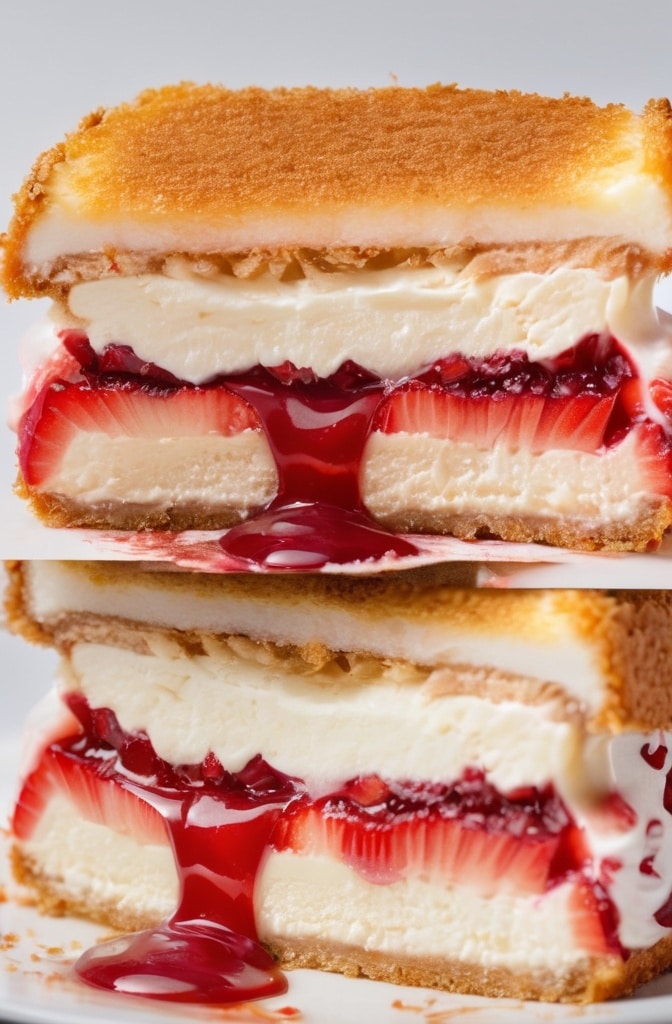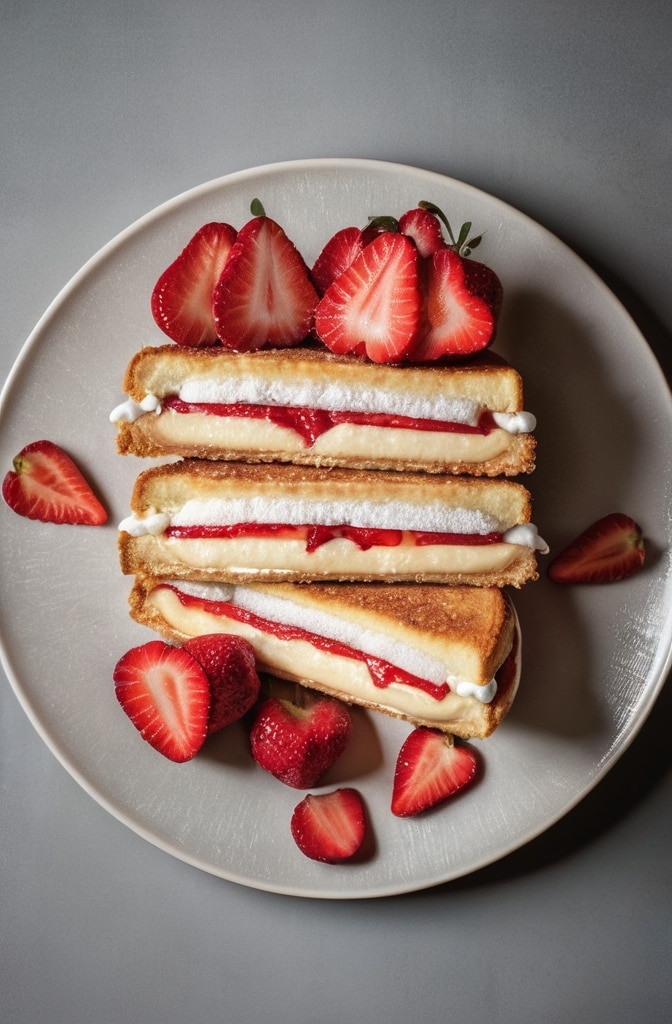Last summer, I stumbled upon a food truck at the Portland Night Market selling what they called “dessert paninis.” The concept seemed absurd—until I bit into their signature creation. The crispy exterior gave way to molten cheese and sweet berries, creating a textural symphony I couldn’t stop thinking about for weeks. I’ve spent months perfecting my own version, and I’m thrilled to finally share this fried strawberry cheesecake sandwich recipe with you.
Let me tell you somthing—this isn’t your standard dessert. It’s the perfect collision of breakfast and dessert, comfort food and gourmet indulgence. The contrast between the warm, buttery, crisp exterior and the cool, creamy cheesecake filling studded with fresh strawberries creates an experience that’ll have your guests begging for the recipe.
1. Ingredients & Substitutions
For the Cheesecake Filling:
- 8 oz (225g) cream cheese, softened to room temperature
- 1/4 cup (50g) granulated sugar
- 1 tablespoon fresh lemon juice
- 1 teaspoon vanilla extract
- Pinch of salt
For the Strawberry Compote:
- 2 cups (300g) fresh strawberries, hulled and quartered
- 3 tablespoons granulated sugar
- 1 tablespoon lemon juice
- 1/2 teaspoon vanilla extract
- Pinch of salt
For the Sandwiches:
- 8 slices brioche bread (thick-cut)
- 4 tablespoons unsalted butter, softened
- 2 tablespoons granulated sugar mixed with 1/2 teaspoon cinnamon (for dusting)
- Powdered sugar (for serving)
The quality of your cream cheese matters tremendously here—Philadelphia brand offers the perfect balance of tang and creaminess, but any full-fat cream cheese will do. For those avoiding dairy, cultured cashew cheese makes a shockingly good substitute, altho it won’t melt quite the same way.
Brioche provides the ideal buttery foundation, but challah or even texas toast can work in a pinch. For gluten-free options, use a sturdy gluten-free bread that won’t fall apart during frying—avoid those overly dense varieties that’ll overwhelm the delicate filling.
Fresh strawberries are essential for the best flavor profile. If you’re making this out of season, good-quality frozen berries can work for the compote, but you’ll need to adjust the cooking time slightly to account for the extra moisture.
2. Step-by-Step Instructions

Preparing the Cheesecake Filling:
- In a medium bowl, beat the softened cream cheese until completely smooth, about 2 minutes. The key here is patience—cold cream cheese will leave you with those dreaded lumps that ruin the silky texture we’re after.
- Add sugar, lemon juice, vanilla extract, and salt, then continue beating until the mixture becomes light and fluffy, approximately 3 minutes. Transfer to a container and refrigerate for at least 30 minutes to firm up.
- Don’t skip the chilling step—a firmer filling will stay put during the assembly and frying stages, preventing that devastating cheese leak that can happen when your filling is too soft.
Making the Strawberry Compote:
- Combine strawberries, sugar, lemon juice, vanilla, and salt in a small saucepan over medium heat. The salt might seem counterintuitive in a sweet dish, but it’s critical for enhancing the natural berry flavor.
- Once the mixture begins to bubble, reduce heat to medium-low and simmer gently, stirring occasionally, until berries break down and the mixture thickens slightly, about 10-12 minutes. You want some texture remaining—we’re not making jam here.
- Remove from heat and cool completely. The compote will continue to thicken as it cools, so don’t worry if it seems a bit loose initially.
Assembling and Cooking the Sandwiches:
- Spread about 2 tablespoons of cheesecake filling onto one side of each bread slice, leaving a 1/2-inch border around the edges to prevent oozing. This border is crucial—skip it, and you’ll have a sticky mess on your hands and in your pan.
- Spoon 1-2 tablespoons of cooled strawberry compote onto 4 of the bread slices, gently spreading it over the cheesecake layer. Press the remaining bread slices on top, cheesecake side down, to create 4 sandwiches.
- Lightly press the edges together and let the sandwiches rest for 5 minutes. This brief resting period helps the filling set and prevents it from escaping during cooking.
- Heat a large skillet or griddle over medium-low heat. The temperature is absolutely critical—too high, and you’ll burn the exterior before the filling warms; too low, and the sandwich becomes soggy.
- Spread softened butter on the outside of each sandwich. Place in the skillet and cook until golden brown and crispy, about 3-4 minutes per side. Work in batches if necessary—crowding the pan is the fastest way to end up with soggy, unevenly cooked sandwiches.
- Immediately after removing from the pan, sprinkle with cinnamon-sugar mixture while the butter is still warm so it adheres properly.
- Cool for 2-3 minutes before slicing diagonally to serve. Dust with powdered sugar just before serving.
3. Cooking Techniques & Science
The magic of this recipe lies in the contrasting temperatures and textures. When frying the sandwiches, you’re essentially creating a sealed pocket where the cream cheese softens but doesn’t completely liquefy. The technical term for this is “stage melting”—the outer molecules of the cream cheese begin to flow while the interior maintains structure.
Brioche’s high butter content creates what food scientists call the Maillard reaction—a non-enzymatic browning that produces hundreds of flavor compounds when the proteins and sugars in the bread react under heat. This reaction is responsible for that irresistible golden crust and nutty aroma that signals your brain “this is gonna be delicious” before you even take a bite.
The addition of lemon juice to both the filling and compote serves dual purposes. Beyond brightening the flavor, the acidity partially denatures the proteins in the cream cheese, creating a smoother texture. It also breaks down pectin in the strawberries, helping them release their juices more readily during cooking.
For optimal results, use a cast-iron skillet if you have one. Its superior heat retention creates even browning and prevents those frustrating hot spots that can burn parts of your sandwich. A well-seasoned cast iron also develops a natural non-stick surface, allowing you to use less butter without sacrificing that crispy exterior.
4. Serving & Pairing Suggestions
Serve these indulgent sandwiches while still warm, but not scalding hot—about 5 minutes after cooking is ideal. The interior should be just warm enough to be gooey without burning your mouth. Cut diagonally to showcase the beautiful layers of filling.
For an elevated plating presentation, try placing the sandwich on a rectangular plate with a line of powdered sugar sifted through a paper stencil. A small ramekin of extra strawberry compote on the side allows guests to add more if desired. A sprig of fresh mint adds a welcome color contrast and aromatic element.
These sandwiches pair beautifully with espresso or cold brew coffee, which cuts through the richness. For a more decadent experience, serve alongside a small scoop of vanilla bean ice cream. The temperature contrast between the warm sandwich and cold ice cream creates a sensory experience that elevates this dish from mere comfort food to a sophisticated dessert worthy of a fine dining establishment.
For brunch service, consider serving smaller portions alongside a glass of Prosecco or a strawberry mimosa. The effervescence and acidity help cleanse the palate between bites of the rich sandwich.
Advanced Variations
Once you’ve mastered the basic technique, consider these professional variations:
Balsamic Reduction Drizzle: Reduce 1 cup of balsamic vinegar to about 1/4 cup to create a syrupy consistency, then drizzle over the plated sandwich. The acidity cuts through the richness while the natural sweetness complements the strawberries.
Herbal Infusion: Add 1 teaspoon of finely chopped fresh basil or mint to the cheesecake filling. The herbal notes create an unexpected but delightful complexity that elevates this from a simple dessert to a culinary conversation piece.
Chocolate Integration: Spread a thin layer of high-quality dark chocolate ganache on the inside of the bread before adding the cheesecake filling. As the sandwich warms during cooking, the chocolate melts into the other components, creating pockets of intense flavor.
Textural Enhancement: Sprinkle 1 tablespoon of crushed graham crackers between the cheesecake and strawberry layers to reference traditional cheesecake crust while adding textural interest.
Troubleshooting Common Issues
Even experienced chefs encounter challenges with this recipe. Here’s how to solve the most common problems:
Filling Leakage: If your filling keeps escaping during cooking, your cream cheese mixture may be too soft. Return it to the refrigerator for 15-20 minutes before assembly. Also, ensure you’re leaving that crucial border around the edges.
Uneven Browning: This usually indicates your cooking surface isn’t heating evenly. Try rotating the sandwich 180 degrees halfway through cooking each side, or invest in a better-quality pan.

Soggy Bread: This happens when the heat is too low or when too much compote is used. Make sure your pan is adequately preheated and drain excess liquid from the compote if it seems too wet.
Too Sweet: Balance is crucial in this recipe. If you find the result cloying, increase the lemon juice in both components by 1/2 teaspoon each, or reduce the sugar in the compote by 1 tablespoon.
The Cultural Context
While this creation might seem like a modern food trend, it actually draws on culinary traditions from multiple cultures. The concept of fried sweet sandwiches appears in various forms worldwide—from French toast to Italian mozzarella in carrozza to Monte Cristo sandwiches.
The Jewish dessert blintzes—crepes filled with sweetened cheese and often served with fruit compote—share similar flavor profiles. Meanwhile, the technique of pan-frying bread with sweet fillings has roots in Eastern European cuisine, where farmers would use leftover bread and seasonal fruits to create satisfying desserts that prevented food waste.
By understanding these cultural connections, we can appreciate this recipe not as a random indulgence but as part of a rich culinary conversation spanning centuries and continents.
Conclusion
The Fried Strawberry Cheesecake Sandwich represents the beautiful intersection of technical skill and creative imagination. The careful balance of temperatures, textures, and flavors creates a dish that’s simultaneously comforting and sophisticated.
What makes this recipe truly special is its versatility. It can be dressed up for an elegant dessert service or simplified for a cozy weekend brunch. The core technique—creating a sealed packet of contrasting textures—provides a foundation for endless experimentation with different fruits, cheeses, and breads.
Remember that the key to success lies in the details: properly softened cream cheese, adequately reduced compote, and most importantly, patient, attentive cooking. Master these elements, and you’ll create a dish that delights both casual eaters and culinary connoisseurs alike.
FAQs About Fried Strawberry Cheesecake Sandwich Recipe
Can I make the components ahead of time?
Absolutely! Both the cheesecake filling and strawberry compote can be made up to 3 days in advance and stored in airtight containers in the refrigerator. This actually improves the flavor as the components have time to meld. Just bring the cheesecake filling to cool room temperature before assembly so it spreads easily.
Why did my filling turn runny during cooking?
This typically happens when the cream cheese mixture isn’t chilled enough before assembly. The filling should have the consistency of softened butter—spreadable but not liquid. Also check that your compote has cooled completely before using, as residual heat can prematurely soften the cheesecake layer.
Can I bake these instead of pan-frying?
While possible, baking won’t yield the same crispy exterior. If you must bake, brush both sides generously with melted butter and bake at 375°F (190°C) for about 8-10 minutes, flipping halfway through. You’ll lose some of the textural magic, but the flavor will still be delicious.
How do I store and reheat leftovers?
Store any leftovers in an airtight container in the refrigerator for up to 2 days. To reheat, use a dry skillet over low heat rather than a microwave, which would make the bread soggy. A toaster oven at 300°F (150°C) for 5-7 minutes also works well for restoring some crispness.
Can I freeze these sandwiches?
I don’t recommend freezing the assembled sandwiches as the texture significantly degrades upon thawing. However, you can freeze the individual components (bread, cheesecake filling, and compote separately) and assemble fresh sandwiches when desired.

